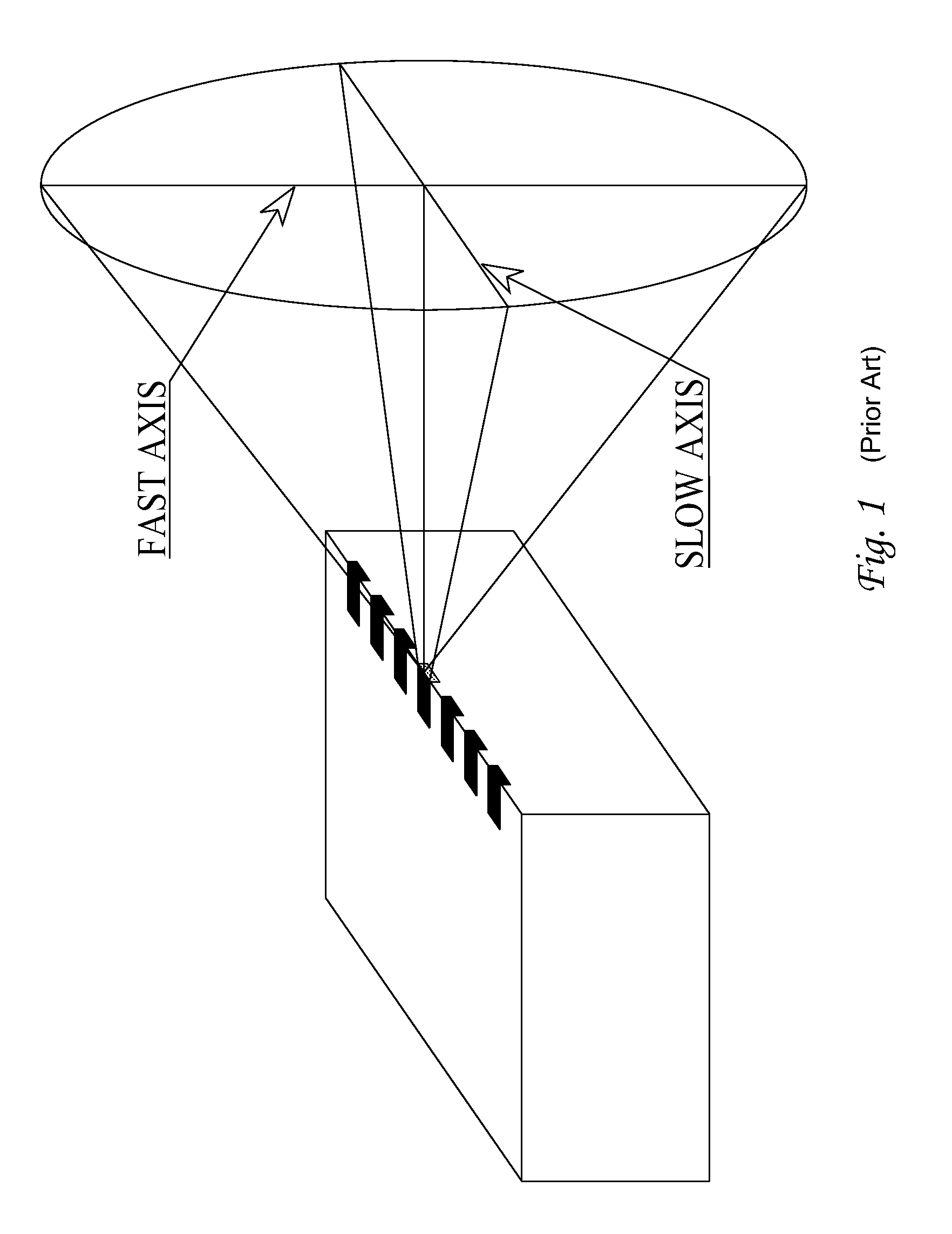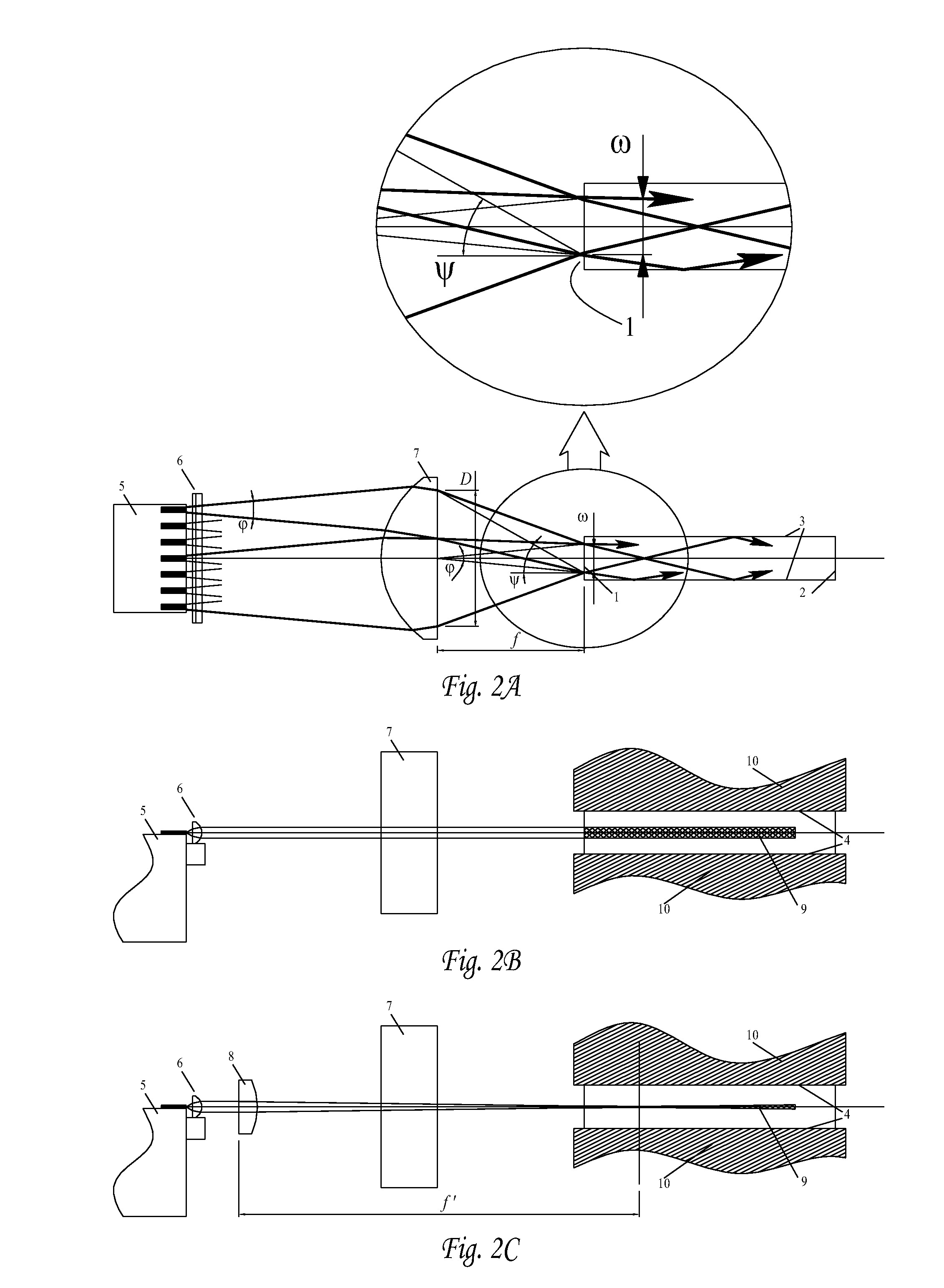Solid-state laser with waveguide pump path (z pump)
a laser and waveguide technology, applied in lasers, laser details, electrical equipment, etc., can solve the problems of poor high output power scaling, high cost of beam shaping optical elements, and difficult overlapping between pumping beams and laser modes, so as to reduce thermal loading, reduce thermal loading, and improve the effect of pumped volum
- Summary
- Abstract
- Description
- Claims
- Application Information
AI Technical Summary
Benefits of technology
Problems solved by technology
Method used
Image
Examples
experiment 1
[0109]Input and output parameters with different reflectivity of the output coupler were measured.
[0110]The output laser power vs. the laser diode pump power is shown in FIG. 12 for output mirror reflectivity R=98, 90, 80, and 50%.
[0111]Laser mirror with R=90% allows the most efficient operation at 1063-nm wavelength. The absolute efficiency was calculated to equal 43.2% and the differential efficiency was 48.4%.
[0112]Maximal laser output was 9.8 W at pumping power 22.7 W. Threshold of the laser operation was measured to be 920 mW.
[0113]The absolute efficiency, slope efficiency, and the threshold power for different coupling mirrors are summarized in Table. 1.
TABLE 1R = 98%R = 90%R = 80%R = 50%Slope Efficiency, %36.8848.3951.0943.08Absolute Efficiency, %34.1943.1740.3526.21Threshold, mW5092018605800
[0114]The intra-cavity losses were measured from the input-output characteristics of the laser. A method for calculation of intra-cavity losses based on the slope efficiency with differen...
experiment 2
[0126]The pumping light wavelength from the laser diode bar depends on the temperature of the bar and drifts by 0.3 nm per 1° C. Usually, it is necessary to control the temperature of the laser diode bar in order to adjust the emission spectrum for the best overlap with absorption bands of the laser medium.
[0127]Waveguide pumping geometry provides a long pumping area and is not expected to exhibit strong dependence of laser operation efficiency upon the temperature of the laser diode bar. In this experiment, the output power of the laser was measured at fixed pump power 17.6 W. The output mirror was flat with reflectivity R=90%. The temperature of the laser diode bar was varied from 10° C. to 34° C. FIG. 13 shows the laser output power of vs. the laser diode bar temperature. The output power changed within the range 6.31 W to 7.33 W when temperature varied from 10° C. to 34° C. that gives stability 15%. In the range from 15° C. to 25° C. range the output power changes from 7.25 to 7...
experiment 3
[0129]Stability is an important parameter for the DPSS lasers. Thermal lensing in laser medium is the main source of laser operation instabilities. Long pumped volume of the waveguide pumping geometry also gives the advantage of lower thermal loading.
[0130]In this experiment, stability of laser operation was measured at fixed pump power 9.5 W. The laser diode temperature was 20° C. stabilised to within 1.5° C. The output power was recorded every second for the duration of 2 hours. Total of 7200 measurements were made. Statistic distribution of these measurements is shown in FIG. 14.
[0131]Arithmetic mean of this distribution is Pmean=2,925.81 mW and the standard deviation σ=3.99 mW. This means that the laser stability for two hours of operation was σ / Pmean=0.13%.
[0132]Repeated measurements within several days demonstrated the same output power within this statistic distribution.
[0133]In conclusion this method provides design of diode bar end pumped solid state lasers, amplifiers and ...
PUM
 Login to View More
Login to View More Abstract
Description
Claims
Application Information
 Login to View More
Login to View More - R&D
- Intellectual Property
- Life Sciences
- Materials
- Tech Scout
- Unparalleled Data Quality
- Higher Quality Content
- 60% Fewer Hallucinations
Browse by: Latest US Patents, China's latest patents, Technical Efficacy Thesaurus, Application Domain, Technology Topic, Popular Technical Reports.
© 2025 PatSnap. All rights reserved.Legal|Privacy policy|Modern Slavery Act Transparency Statement|Sitemap|About US| Contact US: help@patsnap.com



